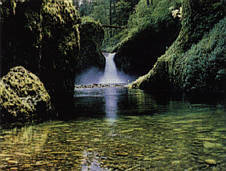


|
 |


Introduction
KH:KH refers to the carbonated hardness of the water. What is KH (carbonated hardness) and why should this concern my fish and me? Simply put KH is your waters buffer to changes in its pH. It is like the sponge of the water. Say you spilled a gallon root beer on your table and you run to the kitchen to get a sponge. You grab the sponge and throw it into the pool of spilled root beer. The sponge only picks up half of it and you cannot ring out the sponge. There is still a half a gallon of root beer on you table. You will need another sponge to soak up the rest. This is what happens in your aquarium. KH in some level should be in your water. Distilled water has zero KH and that is to say it has no sponge. The gallon of root beer on the table will not be picked up with a distilled water sponge. This is one of the reasons why I say distilled water is bad for your tank. After a tank cycles one of the products that get produced is nitric acid. In a tank with a low or no KH factor in the water present the water will fluctuate downward in its pH. Say your pH is 7.4 and your tank has cycled. At your next water change you check your pH and it’s down to below 6.0 on the test. Now most of us who are new to fish are saying “Yeah I hope that happens to my water”. “I have been adding this pH down stuff and it’s still not down”. This is a bad thing, reason being is because when you do a water change you pull out some of the acid and dilute the rest. Also your water has buffer in it and that new sponge sucks up the rest. Wow you went from below 6.0 pH right back up to 7.4 or close to it. As time rolls on you will notice less and less returns toward your original pH level but what is bad is this fast pH swing is hard on the fish. They do not mind a slow pH change but one from below 6 to 7.4 is not tolerated a lot by them. Take it from one who knows. My KH in the water supply at the work tank in the cycling page is a KH of 1. The pH of that tank after cycling dropped like a rock. I have to add KH to the water to keep it stable and monitor it constantly. Adding carbonated hardness to your water is easy and very inexpensive. I bought a container of it for under 3 bucks and I need very little of it to keep the pH around 6.8. What am I measuring when I find the KH of my water? Carbonated hardness is the amount of Calcium carbonate in the water. There are two different ions that are measured. First is CO3 and second HCO3. These two ion compounds are the Alka Seltzer of your fish tank. The higher the KH level the less likely you are to have pH shifts. I would suggest that everyone starting a aquarium for the first time know what their KH level is so you can be ready for fast drop in pH or know with a high pH that your tank should stay fairly stable. I will say that through most of my letters of people with city water it is for the most part a low KH level that must be preferred.
GH:GH stands for General Hardness. General Hardness is measured in degrees of hardness and is the measurement of the amount of carbonate and non-carbonated hardness or total hardness as it is sometimes called as well. The symbol for this is always dH. We already know what is meant by carbonated hardness from reading the first part of this section on KH. But what is non- carbonated hardness? Other salts in the water such as sulfates are present in water and when all of these are added together they represent the GH or over all general hardness. Other ions in the water that add to GH are calcium ions (Ca++) and magnesium ions (Mg++). These properties are present in all but distilled water. The harder the water the more of these compounds are in your water. Now to tell you the truth GH is less important than KH. Other than some fish not tolerating the hardness of the water it truly isn’t a high priority to get your water harder or softer. Unless you hate those hard water stains all over the place most fish tolerant of a wide range in the hardness category. 0 dH to 4 dH would be considered very soft water. Above 20 dH would be considered very hard water. A chart I have gotten from a book describes it as:

Most fish can be happy with 0 to 16 dH without a problem. Higher than that it depends on the species and some even prefer it. I have also read somewhere that using a commercial water softener is not a fix for fish. This is one reason that this page was long in coming. The problem with it and I can not quote from a book so my being accurate on this can be off. But as I read it, it was that the water would feel soft to you and I. And the water properties would change but to the fish would know no difference and still view the water as hard. For this reason the method that they suggested to lower a GH level were to filter water via peat or some other ion exchange method. Commercial water softeners will not harm the fish but the feel of the water to them would feel as if the water were the same hardness. One thing I should mention about peat filtering. Other than I would not suggest this to a newbie. Peat filtering also causes the water levels to become more acidic. Each degree of hardness corresponds to 30mg of calcium or magnesium carbonate per liter of water. Also a use of a cation exchanger would also do the job. To raise levels of hardness you would have to add 30mg of calcium or magnesium per liter of water for each degree of hardness you would want to increase it to. Rocks containing calcium such as limestone can leech calcium into the water and raise your levels of GH to a level you would want.
Sorry so long in coming and hopefully the next part pH will come faster!!! As always E-mails are always welcome! Keep it wet! Mags |

|
|
|
|